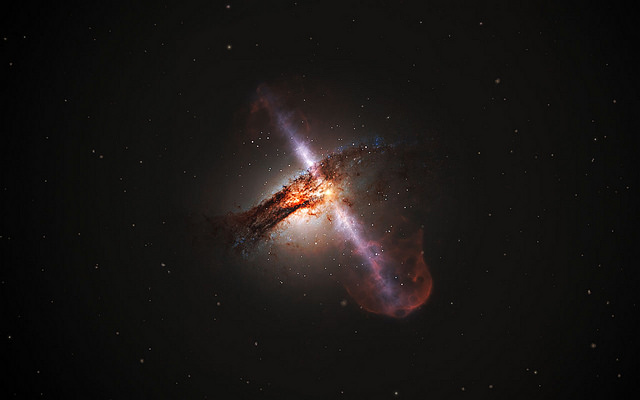
Big news: Scientists working at aLIGO, the advanced Laser Interferometer Gravitational-Wave Observatory, are reporting today that they have confirmed the existence of, and measured, gravitational waves. Read on.
***
In a big (and rather entertaining) press conference that’s still going on, they announced that they’ve detected gravitational waves emitted roughly 1.3 billion years ago (0.9 to 1.6 billion) from the merging of two black holes. The signal, which originated in the direction of the Large Magellanic Cloud, was detected on September 14 of last year, and they’ve been confirming their numbers ever since.
The black holes that merged were a little more than thirty solar masses each and a hundred and fifty miles wide. They spiralled in together at intense speeds, reaching about half of the speed of light. When they hit, it made a pretty big bang. According to Kip Thorne (who, along with Ronald Drever and Rainer Weiss, is one of the three people who’ll probably get the Nobel Prize for this) for an exceedingly brief time, it emitted more than fifty times the power of every star in the observable universe; it did so for such a brief period of time, however, that it “only” used up three solar masses of energy in gravitational wave emission.
The “stretch and squish” in spacetime caused by the gravity waves passing through the Earth was, to put it mildly, very, very small. Quite literally, they were looking for differences on the order of one one-thousandth the width of a proton. For reference, that’s about the same as measuring the distance from the Earth to the Sun to the accuracy of the width of a human hair.
The team confirmed the signal two ways: first, aLIGO has two sites, one at the Hanford Site in Washington State and one in Livingston, Louisiana. The signal arrived identically at both sites, and every other possibility for the signal has been ruled out (hence the delay). Second, they were able to mathematically model the kind of gravitational waves that would be generated by a collision of two black holes, and this signal matches that pattern perfectly.
The signal was actually detected as soon as they turned the newly upgraded aLIGO on (originally there was no “a”), and with coming upgrades, they expect to see multiple events a year.
Not to put too fine a point on it, but this is a very big deal. This confirms the moment when we start a new field of astronomy. Rainer Weiss, during the Q&A after the announcement, said that he is pushing for a collaboration between the US and Europe to move into lower noise environments — for example, a space-based laser interferometer like the much-stalled LISA. The signal we can measure above the noise lasted only 0.2 seconds, but they can calculate what should be below the noise, and I, for one, can’t wait to hear what they discover next.
The paper in which they announce the discovery, “Observation of Gravitational Waves from a Binary Black Hole Merger,” has been published today in the journal Physical Review Letters.
***
Richard Ford Burley is a writer and doctoral candidate at Boston College, as well as an editor at Ledger, the first academic journal devoted to Bitcoin and other cryptocurrencies. In his spare time he writes about science, skepticism, feminism, and futurism here at This Week In Tomorrow.
